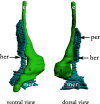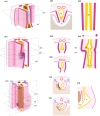Initial morphological symmetry breaking in the foregut and development of the omental bursa in human embryos
- PMID: 33145764
- PMCID: PMC7930768
- DOI: 10.1111/joa.13344
Initial morphological symmetry breaking in the foregut and development of the omental bursa in human embryos
Abstract
Bilaterally symmetrical primordia of visceral organs undergo asymmetrical morphogenesis leading to typical arrangement of visceral organs in the adult. Asymmetrical morphogenesis within the upper abdomen leads, among others, to the formation of the omental bursa dorsally to the rotated stomach. A widespread view of this process assumes kinking of thin mesenteries as a main mechanism. This view is based on a theory proposed already by Johannes Müller in 1830 and was repeatedly criticized, but some of the most plausible alternative views (initially proposed by Swaen in 1897 and Broman in 1904) still remain to be proven. Here, we analyzed serial histological sections of human embryos between stages 12 and 15 at high light microscopical resolution to reveal the succession of events giving rise to the development of the omental bursa and its relation to the emerging stomach asymmetry. Our analysis indicates that morphological symmetry breaking in the upper abdomen occurs within a wide mesenchymal plate called here mesenteric septum and is based on differential behavior of the coelomic epithelium which causes asymmetric paragastric recess formation and, importantly, precedes initial rotation of stomach. Our results thus provide the first histological evidence of breaking the symmetry of the early foregut anlage in the human embryo and pave the way for experimental studies of left-right symmetry breaking in the upper abdomen in experimental model organisms.
Keywords: coelom; left-right symmetry breaking; mesentery; omental bursa; stomach.
© 2020 The Authors. Journal of Anatomy published by John Wiley & Sons Ltd on behalf of Anatomical Society.
Figures









References
-
- Aben, K. & de Bakker, B.S. (2012) The embryonic development of the pneumato‐enteric recess. Amsterdam: Amsterdam University College.
-
- Bartram, U. , Wirbelauer, J. & Speer, C.P. (2005) Heterotaxy syndrome – Asplenia and polysplenia as indicators of visceral malposition and complex congenital heart disease. Biology of the Neonate, 88, 278–290. - PubMed
-
- Blum, M. & Ott, T. (2018) Animal left‐right asymmetry. Current Biology, 28, R301–R304. - PubMed
-
- Broman, I. (1904) Die Entwicklungsgeschichte der Bursa omentalis und aehnlicher Rezessbildungen bei den Wirbeltieren. Wiesbaden: Bergmann.
-
- Broman, I. (1905) Über die Entwickelung der Mesenterien der Leberligamente und der Leberform bei den Lungenfischen. Jena, Germany: Fischer.
Publication types
MeSH terms
LinkOut - more resources
Full Text Sources

